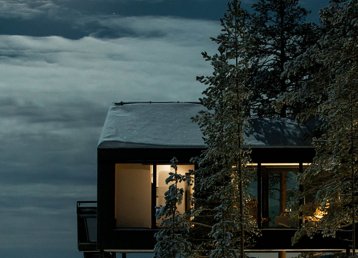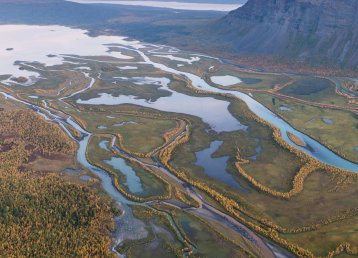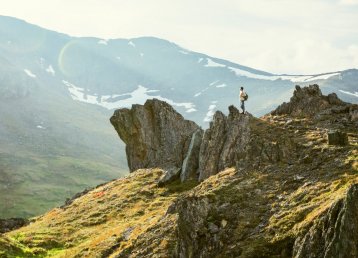After the longest cul-de-sac in Sweden, or the Road West as it’s often called by the locals, just before you reach Stora Sjöfallet, you’ll find Naturum Laponia. At first, it’s hidden by sparse, old-growth forest, but once you’re at the edge of the forest, the landscape opens up. This is where forests, mountains, rivers and lakes come together.
Surrounded by the mighty mountains
A few stones’ throws from the beach by lake Lánja, on the Viedásnjárgga headland, lies Naturum Laponia. We go there during that magical part of autumn when leaves glow in all nuances of green, gold and red. It’s grey with low clouds as we leave Gällivare, but the forecast promises nicer weather in the mountains, and we cross our fingers. True enough, as we dive westwards the clouds scatter and soon the autumn sun is shining.
The mountain landscape opens up, and a sense of space greets us I can’t even begin to explain. To the right is the forest, to the left mighty mountains, and we keep driving along the winding road. We take a left, park the car and stop for a moment to breathe in the fresh, clear autumn air. Then we walk along a path through the trees for a couple of hundred metres. It’s a wide path, and it’s easy to walk. At the end of the woods, the landscape expands and takes our breath away. Right there, a few stones’ throws from the beach by lake Lánja, on the Viedásnjárgga headland, lies Naturum Laponia.
Naturum Laponia
Naturum Laponia is made up of Snöfällan – a building designed by architects and local artisans – and some traditionally built Sámi huts. The location was chosen by the Sámi herding unit Unna Tjerusj to make sure visitors could be welcomed without it affecting the reindeer herding in the area.
The headland that is home to Naturum Laponia is subject to harsh weather and winds; the idea is to let the weather affect the building. In time the untreated wood will go grey, and during winter snow falls onto the broad beams supporting the wall. You can see the snow fall in layers against the windows of the building, hence its name: the Snow Trap. The main entrance and the hut doors face east because of the strong westerly winds. When the time comes, the building can be taken down from its poles and removed without too much impact on the ground.
The huts that belong to the Naturum are not far from the main building, the Snow Trap. They are used for baking gáhkko (Sámi bread), tell stories or give information on herbs and other things.
Also read
Stories told with namesA place for storytelling
I don’t really know what my expectations were as we drove here, but what I do know is that I’m getting much more than that. It’s bigger. It’s real. Exhibitions can vary in terms of quality, but this is much more than just an exhibition.
A naturum is a place for storytelling, and at Naturum Laponia they tell part of the story why this place was designated as one of UNESCO’s World Heritage Sites. The stories might tell you about the mountains on the other side of the lake, or how reindeer find their way here every year. The exhibition is about the entire World Heritage Laponia and gives you an insight into the living Sámi culture and the captivating nature all around you.
Naturum Laponia opened in autumn 2014 and is a gateway to the four national parks Muddos, Stora Sjöfallet, Sarek and Padjelanta, the two nature reserves Sjaunja and Stubba, and nine Sámi herding units.
Visitors come from near and far. Kristin Nilsson is the manager of Naturum, and she tells us it’s getting more and more popular.
“Mainly it’s families with children who come here, since we have plenty of educational activities for the little ones: games, storytelling and guided tours adapted to children. But there are also many locals who come here when they have friends and family visiting.”
“It’s not unusual for hikers to stop by if they’re in the area and it’s a positive surprise for them to find us here, so far from town.”
Tip!
If you’re unable to go to the World Heritage, there are visitors centres with smaller exhibitions you can visit in Gällivare, Porjus, Jokkmokk and Kvikkjokk. Read more at laponia.nu.
Take a walk
Stuor Muorkke, or Stora Sjöfallet in Swedish, means ‘the place between two lakes’. This is where a centenary forest and steep mountains meet wide rivers and lakes placed like a pearl necklace. Around the Naturum there are plenty of day treks for everyone, whether you’re an amateur or professional hiker.
Soldalen takes you from the old-growth forest to the mountains, and if you walk over to Sjöfallsudden, you get to see the Stuormuorkkegårttje waterfall enter Lánjas. You can also participate in one of the world heritage walks arranged by the staff at Naturum.
If you hike in the area: keep your eyes open – and angled towards the ground. Especially if you walk in places where there used to be a permanent snow cover. The warming climate melts snowfields and glaciers, and archaeological findings come to light. If you find something it’s important that you bring it and try to mark the spot where you found it before you take it to for example Ájtte Mountain and Sámi Museum in Jokkmokk.
Also read
Padjelanta, walking on higher groundEverything but a wilderness
Sometimes this region is called Europe’s last wilderness, but this place is everything but a wilderness. Old hearths, settlements and other traces in the landscape show that people have roamed these lands for thousands of years – since the last inland ice melted. Every brook, forest, cliff, hill, lake and river has a name.
Laponia is a world heritage due to its culture and nature. It’s an area so unique that it’s important to preserve it for future generations. Laponia is yours, ours and the world’s heritage.
Learn more
Naturum Laponia is a gateway to four national parks, two nature reserves and nine Sámi herding units. This is where to come to find out more, but also for ideas on how to explore the 9,400 km2 world heritage on your own. Opening hours and program at laponia.nu.






























